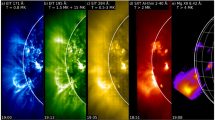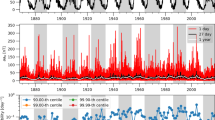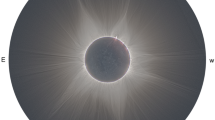Abstract
We compare the geoeffective parameters of halo coronal mass ejections (CMEs). We consider 50 front-side full-halo CMEs (FFH CMEs), which are from the list of Michalek, Gopalswamy, and Yashiro (Solar Phys. 246, 399, 2007), whose asymmetric-cone model parameters and earthward-direction parameter were available. For each CME we use its projected velocity [V p], radial velocity [V r], angle between cone axis and sky plane [γ] from the cone model, earthward-direction parameter [D], source longitude [L], and magnetic-field orientation [M] of its CME source region. We make a simple linear-regression analysis to find out the relationship between CME parameters and Dst index. The main results are as follows: i) The combined parameters [(V r D)1/2 and V r γ] have higher correlation coefficients [cc] with the Dst index than the other parameters [V p and V r]: cc=0.76 for (V r D)1/2, cc=0.70 for V r γ, cc=0.55 for V r, and cc=0.17 for V p. ii) Correlation coefficients between V r γ and Dst index depend on L and M; cc=0.59 for 21 eastern events [E], cc=0.80 for 29 western events [W], cc=0.49 for 17 northward magnetic-field events [N], and cc=0.69 for 33 southward magnetic-field events [S]. iii) Super geomagnetic storms (Dst≤−200 nT) only appear in the western and southward magnetic-field events. The mean absolute Dst values of geomagnetic storms (Dst≤−50 nT) increase with an order of E+N, E+S, W+N, and W+S events; the mean absolute Dst value (169 nT) of W+S events is significantly larger than that (75 nT) of E+N events. Our results demonstrate that not only do the cone-model parameters together with the earthward-direction parameter improve the relationship between CME parameters and Dst index, but also the longitude and the magnetic-field orientation of a FFH CME source region play a significant role in predicting geomagnetic storms.






Similar content being viewed by others
References
Abramenko, V.I.: 1986, Glav. Astr. Obs. 8, 83. ADS: 1986BsolD...8...83A .
Brueckner, G.E., Howard, R.A., Koomen, M.J., Korendyke, C.M., Michels, D.J., Moses, J.D., Socker, D.G., Dere, K.P., Lamy, P.L., Llebaria, A., Bout, M.V., Schwenn, R., Simnett, G.M., Bedford, D.K., Eyles, C.J.: 1995, Solar Phys. 162, 357. doi: 10.1007/BF00733434 , ADS: 1995SoPh..162..357B .
Brueckner, G.E., Delaboudinière, J.-P., Howard, R.A., Paswaters, S.E., St. Cyr, O.C., Schwenn, R., Lamy, P., Simnett, G.M., Thompson, B., Wang, D.: 1998, Geophys. Res. Lett. 25, 3019. doi: 10.1029/98GL00704 , ADS: 1998GeoRL..25.3019B .
Delaboudinière, J.-P., Artzner, G.E., Brunaud, J., Gabriel, A.H., Hochedez, J.F., Millier, F., Song, X.Y., Au, B., Dere, K.P., Howard, R.A., Kreplin, R., Michels, D.J., Moses, J.D., Defise, J.M., Jamar, C., Rochus, P., Chauvineau, J.P., Marioge, J.P., Catura, R.C., Lemen, J.R., Shing, L., Stern, R.A., Gurman, J.B., Neupert, W.M., Maucherat, A., Clette, F., Cugnon, P., Van Dessel, E.L.: 1995, Solar Phys. 162, 291. doi: 10.1007/BF00733432 , ADS: 1995SoPh..162..291D .
Gonzalez, W.D., Joselyn, J.A., Kamide, Y., Kroehl, H.W., Rostoker, G., Tsurutani, B.T., Vasyliunas, V.M.: 1994, J. Geophys. Res. 99, 5771. doi: 10.1029/93JA02867 , ADS: 1994JGR....99.5771G .
Gopalswamy, N., Yashiro, S., Akiyama, S.: 2007, J. Geophys. Res. 112, A06112. doi: 10.1029/2006JA012149 , ADS: 2007JGRA..112.6112G .
Gosling, J.T., McComas, D.J., Phillips, J.L., Bame, S.J.: 1991, J. Geophys. Res. 96, 7839. doi: 10.1029/91JA00316 , ADS: 1991JGR....96.7831G .
Kang, S.-M., Moon, Y.-J., Cho, K.-S., Kim, Y.-H., Park, Y.D., Baek, J.-H., Chang, H.-Y.: 2006, J. Geophys. Res. 111, A05102. doi: 10.1029/2005JA011445 , ADS: 2006JGRA..111.5102K .
Kim, R.-S., Cho, K.-S., Moon, Y.-J., Kim, Y.-H., Yi, Y., Dryer, M., Bong, S.-C., Park, Y.D.: 2005, J. Geophys. Res. 110, A11104. doi: 10.1029/2005JA011218 , ADS: 2005JGRA..11011104K .
Kim, R.-S., Cho, K.-S., Kim, Y.-H., Park, Y.D., Moon, Y.-J., Yi, Y., Lee, J., Wang, H., Song, H., Dryer, M.: 2008, Astrophys. J. 677, 1378. doi: 10.1086/528928 , ADS: 2008ApJ...677.1378K .
Kim, R.-S., Cho, K.-S., Moon, Y.-J., Dryer, M., Lee, J., Yi, Y., Kim, Y.-H., Wang, H., Park, Y.D., Kim, Y.H.: 2010, J. Geophys. Res. 115, A12108. doi: 10.1029/2010JA015322 , ADS: 2010JGRA..11512108K .
Ku, H.H.: 1966, J. Res. Natl. Bur. Stand. 70C, 262.
Michalek, G.: 2006, Solar Phys. 237, 101. doi: 10.1007/s11207-006-0075-8 , ADS: 2006SoPh..237..101M .
Michalek, G., Gopalswamy, N., Yashiro, S.: 2003, Astrophys. J. 584, 472. doi: 10.1086/345526 , ADS: 2003ApJ...584..472M .
Michalek, G., Gopalswamy, N., Yashiro, S.: 2007, Solar Phys. 246, 399. doi: 10.1007/s11207-007-9081-8 , ADS: 2007SoPh..246..399M .
Michalek, G., Gopalswamy, N., Lara, A., Yashiro, S.: 2006, Space Weather 4, S10003. doi: 10.1029/2005SW000218 , ADS: 2006SpWea...410003M .
Moon, Y.-J., Cho, K.-S., Dryer, M., Kim, Y.-H., Bong, S.-C., Chae, J., Park, Y.D.: 2005, Astrophys. J. 624, 414. doi: 10.1086/428880 , ADS: 2005ApJ...624..414M .
Neter, J., Kutner, M.H., Wasserman, W., Nachtsheim, C.: 1996, Applied Linear Statistical Models, 4th edn., McGraw-Hill/Irwin, New York.
Pevtsov, A.A., Canfield, R.C.: 2001, J. Geophys. Res. 106, 25191. doi: 10.1029/2000JA004018 , ADS: 2001JGR...10625191P .
Scherrer, P.H., Bogart, R.S., Bush, R.I., Hoeksema, J.T., Kosovichev, A.G., Schou, J., Rosenberg, W., Springer, L., Tarbell, T.D., Title, A., Wolfson, C.J., Zayer, I., MDI Engineering Team: 1995, Solar Phys. 162, 129. doi: 10.1007/BF00733429 , ADS: 1995SoPh..162..129S .
Song, H., Yurchyshyn, V., Yang, G., Tan, C., Chen, W., Wang, H.: 2006, Solar Phys. 238, 141. doi: 10.1007/s11207-006-0164-8 , ADS: 2006SoPh..238..141S .
Srivastava, N., Venkatakrishnan, P.: 2004, J. Geophys. Res. 111, A10103. doi: 10.1029/2003JA010175 , ADS: 2004JGRA..10910103S .
Wang, Y.M., Ye, P.Z., Wang, S., Zhou, G.P., Wang, J.X.: 2002, J. Geophys. Res. 107, 1340. doi: 10.1029/2004JA010410 , ADS: 2004JGRA..109.9101Z .
Zhang, J., Dere, K.P., Howard, R.A., Bothmer, V.: 2003, Astrophys. J. 582, 520. doi: 10.1086/344611 , ADS: 2003ApJ...582..520Z .
Zhang, J., Richardson, I.G., Webb, D.F., Gopalswamy, N., Huttunen, E., Kasper, J.C., Nitta, N.V., Poomvises, W., Thompson, B.J., Wu, C.-C., Yashiro, S.: 2007, J. Geophys. Res. 112, A10102. doi: 10.1029/2007JA012321 , ADS: 2007JGRA..11210102Z .
Zhao, X.P., Webb, D.F.: 2003, J. Geophys. Res. 108, 1234. doi: 10.1029/2002JA009606 , ADS: 2003JGRA..108.1234Z .
Acknowledgements
This work was supported by the BK21 plus program through the National Research Foundation (NRF) funded by the Ministry of Education of Korea, Basic Science Research Program through the NRF funded by the Ministry of Education (NRF-2013R1A1A2012763), NRF of Korea Grant funded by the Korean Government (NRF-2013M1A3A3A02042232), and the Korea Meteorological Administration/National Meteorological Satellite Center. R-SK has been supported by the Construction of Korean Space Weather Center as the project of KASI and Research Fellowship for Young Scientists of KRCF. The CME catalog is generated and maintained by the Center for Solar Physics and Space Weather, Catholic University of America, in cooperation with the Naval Research Laboratory and NASA. SOHO is a mission of international cooperation between the ESA and NASA. The Dst index is provided by the World Data Center for Geomagnetism at Kyoto University.
Author information
Authors and Affiliations
Corresponding author
Rights and permissions
About this article
Cite this article
Lee, JO., Moon, YJ., Lee, KS. et al. Dependence of Geomagnetic Storms on Their Associated Halo CME Parameters. Sol Phys 289, 2233–2245 (2014). https://doi.org/10.1007/s11207-013-0466-6
Received:
Accepted:
Published:
Issue Date:
DOI: https://doi.org/10.1007/s11207-013-0466-6




